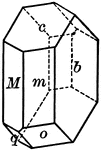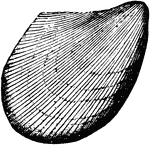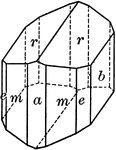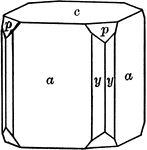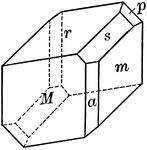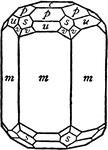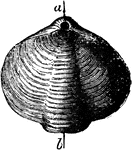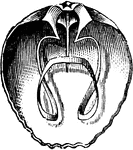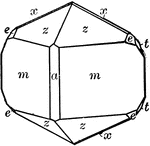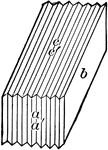
Albite
"Triclinic. Twinning very common, according to the albite law and evidenced by fine striation lines…
Alluvial Fan
Diagram showing the progressive overlapping of the successive divisions of an alluvial fan, away from…
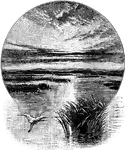
Amazon River
The Amazon River is the largest, most voluminous river on earth, having a greater total flow than the…

Amphibole
"Monoclinic. Crystals prismatic in habit; the prism faces make angles of 55 and 125 degrees with each…
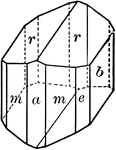
Amphibole
"Monoclinic. Crystals prismatic in habit; the prism faces make angles of 55 and 125 degrees with each…
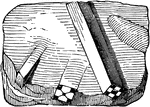
Andalusite
"Andalusite is an aluminum silicate...found in imbedded crystals in clay slate." -Dana, 1883

Paradoxides Harlani
Paradoxides was a genus of relatively large trilobites, extinct marine arthropods, that form the class…

Apatite
"A complex crystal of apatite with the faces of a third-order pyramid upon it." — Ford, 1912

Apatite
"Hexagonal; tri-pyramidal. Crystals usually long prismatic in habit; sometimes short prismatic or tabular.…

Apatite
"Hexagonal; tri-pyramidal. Crystals usually long prismatic in habit; sometimes short prismatic or tabular.…
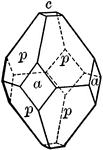
Apophyllite
"Tetragonal. Usually shows a combination of prism of second order, pyramid of first and basal plane."…
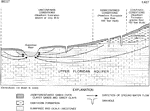
Upper Floridan Aquifer
"Generalized schematic of the hydrogeology of the study area. 1, unconfined conditions (Hawthorn Formation…
Aragonite
"Orthorhombic. Acicular pyramidal; consisting of a prism terminated by a combination of a very steep…

Aragonite
"Orthorhombic. Tabular; consisting of prominent brachypinacoid faces modified by a prism and a low brachydome."…

Arsenopyrite
"Orthohombric. Usually in tabular diamond-shaped crystals, formed by a short prism terminated by low…
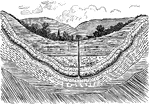
Artesian Well
Artesian Wells differ from ordinary wells in that their waters are discharged by natural pressures on…

Pacops Articulate
An ancient articulate from the Paleozoic time, Pacops bufo from the Hamilton group.
Coral Island of Atoll
"Atolls. A coral island commonly consists of a narrow rim of reef, surrounding a lagoon." -Dana, 1880
Section of Coral Island of an Atoll
"represents a section of an island, from the ocean (o) to the lagoon (l). On the ocean side, from o…
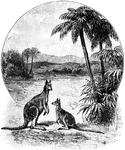
Australian Scenery
Australia's 7,686,850 square kilometers landmass is on the Indo-Australian Plate. Surrounded by Indian,…

Symmetry axis
"A crystal has a center of symmetry if an imaginary line is passed from some point on its surface through…

Barite
"Orthohombic. Crystals usually tabular parallel to base; often diamond shaped because of the presence…
Barite
"Orthohombic. Crystals usually tabular parallel to base; often diamond shaped because of the presence…

Basalt
"Columnar structure in the basalt of the main sheet, south end of East Hill Cliff, near South Britain,…
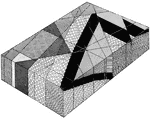
Basalt Diagram
"Diagram to illustrate the inferred structure in the vicinity of the "Triangle." Arkose conglomerate…

Basin
"Idealized profile to show the supposed structure in the rampart slope of the basin to the west of Ragland."…
Bassin du Puy
General view, in part schematic, of the "Bassin du Puy" and the "Chaine du Velay" or "Chaine du Deves,"…

Beryl
"Hexagonal. Strong prismatic habit. Frequently vertically striated and grooved. Forms usually present…
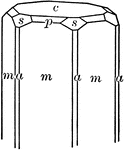
Beryl
"Hexagonal. Strong prismatic habit. Frequently vertically striated and grooved. Forms usually present…
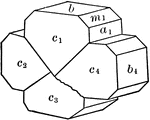
Bournonite
"Orthohombric. Crystals usually short prismatic to tabular. Sometimes quite complex with many prism,…

Pentamerus Brachiopod
A mollusk radiate from the Paleozoic time, Pentamerus oblongus, a brachiopod from the Clinton group.

